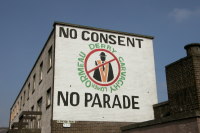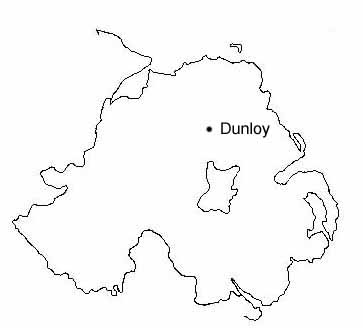|

Parades and Marches - Areas Where Parades and Marches Have Proved Contentious
[Key_Events] [KEY_ISSUES] [Conflict_Background] PARADES: [Menu] [Reading] [Summary] [Background] [Chronology_1] [Chronology_2] [Developments_Drumcree] [North_Review] [Statistics] [Sources] Material is added to this site on a regular basis - information on this page may change
Alphabetical List of Main Areas of Contention
This is a draft (v1) list of the main geographical areas in Northern Ireland where parades and marches have proved to be contentious. The dispute revolves around two conflicting rights. The right to march which is claimed by the Loyal orders as a legitimate expression of their cultural heritage. And on the other hand, the rights of Catholic residents not to have to endure what they view as sectarian 'coat-trailing' and their right to be consulted on controversial parades through their area.
Bellaghy Bellaghy is a small village in South Derry with a 97 per cent Nationalist population. In August of each year tensions build up as the Apprentice Boys from neighbouring towns 'walk' through the village on their return from the main Derry Apprentice Boys annual parade on the Saturday nearest 12 August. In 1996 the Nationalist residents staged a sit-down protest in the village but were forcefully removed by the police to allow the Apprentice Boys to march through. The following day, the Royal Black Preceptory also intended to march through the village, to the top and back again, after a church service. That afternoon Nationalist protestors staged another sit-down protest thus blocking off the street and refusing the Blackmen passage through. The stand-off continued for 20 hours until the following morning, when an agreement was reached between the Black Preceptory and Bellaghy Residents Group. The chairman of the Bellaghy Residents Group, James Hasson, claimed that bands were brought in from neighbouring villages and towns in an attempt to deliberately provoke Nationalist residents.
Bogside
The 12 August Apprentice Boys parade is second only to the 12 July parade and is the biggest parading event in Derry. Its route along the city walls, and particularly past the Bogside, goes against the wishes of the majority of the people of the city. Over the past few years residents have come together to form the Bogside Residents Group. This group accepts that the Apprentice Boys wish to maintain their traditions, but objects to the manner in which they do so. That is, they ignore the principle of consent and apparently adopt a dismissive attitude to the rights of Nationalists. 1995 saw serious disturbances at the Apprentice Boys parades in Derry. The following year, 1996, Nationalists protested against the Apprentice Boys being allowed to walk the city walls and many people in Northern Ireland feared another Drumcree style stand-off. However, the Apprentice Boys decided to postpone the parade to "a time and a date of our choosing" and the situation passed off peacefully.
Drumcree / Garvaghy Road Map of the Garvaghy Road area
In 1995 and 1996, the RUC prevented the Portadown District Orange Lodge from marching along the Garvaghy Road on its return journey from a service in Drumcree Parish Church. Orangemen refused to be dispersed or re-routed, and thus began a stand-off between the police and Orangemen which lasted for two days in 1995 and four days in 1996, before the police finally conceded and allowed the Orangemen to parade along the road. The whole affair caused serious rioting throughout Northern Ireland and resulted in loss of life, injuries, damage to property and a breakdown of community relations. As the 12 July approached in 1997, both residents of Garvaghy Road and the Orange Orders feared a repeat of the previous two years. Over the months leading up to the parade there was been some communication between the two groups. On 5 June 1997 the County Armagh Grand Orange Lodge sent letters to all the residents of the Garvaghy Road, outlining its position, its parading tradition, and inviting constructive comments from those in Garvaghy Road. On 11 June 1997 the residents of Garvaghy Road published a letter in response to this, outlining in turn their own position and fears, and their hopes to reach some kind of peaceful agreement. On the following day (12 June 1997) the two Belfast morning newspapers, the Irish News and the Newsletter, both published a joint editorial appealing for peaceful settlement over the parade dispute. In this they acknowledged the rights of both the Orange Order and the residents of Garvaghy Road, and encouraged them to continue with their dialogue. The editorial put forward the proposal of an accommodation period of two years, whereby the parade would be allowed to pass along the Garvaghy Road one year but re-routed the other year. This was seen as a way of building up trust on both sides. However as it turned out the decision was taken, by the Chief Constable of the Royal Ulster Constabulary (RUC) and the Secretary of State, to force the march down the Garvaghy Road. Large numbers of troops and police were used to seal off the area in the early hours of the morning and the march was pushed through at midday. For further information on Drumcree, please see the section on Developments at Drumcree, 1995-2000.
Dunloy
On the morning of the 10 August 1996 residents from Dunloy held a peaceful protest at the time when Apprentice Boys were due to parade through the village before setting off for Derry. Due to the protest the Apprentice Boys had to leave for Derry without parading through the village. That evening they attempted to parade through the village on their return from Derry and were accompanied by an influx of supporters from neighbouring villages and towns. The Dunloy Residents Group agreed to allow local members, of which there were about 40, access to the Orange Hall but without any bands. The Apprentice Boys did not accept this arrangement. By this stage there were approximately 1,500 Apprentice boys and supporters. The police prevented them from marching and there followed violent confrontations between Apprentice Boys and the RUC which lasted for several hours. The RUC fired 10 plastic bullets.
Newtownbutler Newtownbutler, a small border town in County Fermanagh, like the other contentious areas is also predominantly Nationalist. Problems arise in this town when the Royal Black Institution want their 'traditional' parades to pass along the village main street and Nationalists hold counter-demonstrations.
Ormeau Road The Ormeau Road is a main road in South Belfast and due to demographical changes over the years the lower part of it has become predominantly Nationalist. The main reason for contention in this area is that each year Ballynafeigh Orange Lodge uses the road for feeder marches to main parades. The situation has worsened since February 1992 when the loyalist Ulster Freedom Fighters (UFF) shot dead five Catholic men in a betting shop on the lower Ormeau Road. The following July marchers chanted and jeered as they passed the betting shop causing feelings of anger and resentment among the Nationalist population and a determination that the parades should not be allowed to go through that area. Residents established the Lower Ormeau Concerned Community (LOCC) {external_link} group which is dedicated to the re-routing of all, what they term "sectarian", parades from the Lower Ormeau Road. In 1996, following the stand-off at Drumcree, attention became focused on the Ormeau Road. The LOCC had taken their case to court in a last attempt to have the 12 July parade re-routed but were unsuccessful. At 5pm on the evening of 11 July the RUC and British Army entered the area in large numbers, blocking off streets, and effectively sealing many residents into their homes. The LOCC had organised a prayer service at 9pm that evening but were prevented from leaving their homes by the RUC, who had all entrances and exits blocked off. The following morning however residents were able to get to the main Ormeau Road where they held a peaceful sit-down protest. The parade passed with the marchers and protestors separated by police shields and land rovers. However, the events on the Lower Ormeau sparked off rioting and hijacking in other Nationalist areas of Belfast.
|
CAIN
contains information and source material on the conflict
and politics in Northern Ireland. CAIN is based within Ulster University. |
|
|
|||
|
Last modified :
|
||
|
| ||


 Dunloy is a small, almost exclusively, Nationalist village
in North Antrim, near Ballymoney. Tensions rise in Dunloy in August
as the Apprentice Boys prepare for their annual celebrations.
The Apprentice Boys meet at the
Dunloy is a small, almost exclusively, Nationalist village
in North Antrim, near Ballymoney. Tensions rise in Dunloy in August
as the Apprentice Boys prepare for their annual celebrations.
The Apprentice Boys meet at the